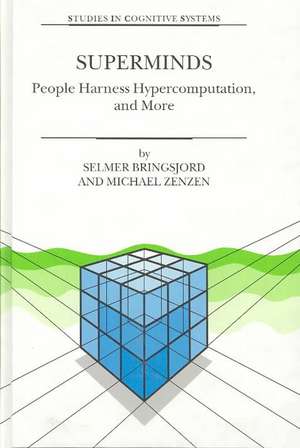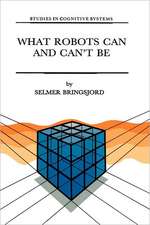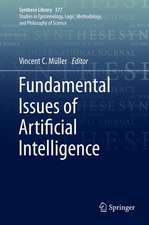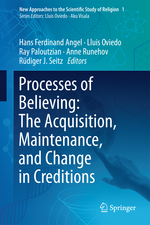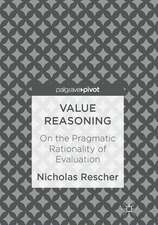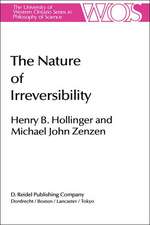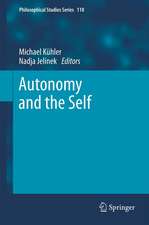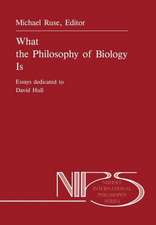Superminds: People Harness Hypercomputation, and More: Studies in Cognitive Systems, cartea 29
Autor Selmer Bringsjord, M. Zenzenen Limba Engleză Hardback – 31 mar 2003
| Toate formatele și edițiile | Preț | Express |
|---|---|---|
| Paperback (1) | 649.06 lei 43-57 zile | |
| SPRINGER NETHERLANDS – 31 mar 2003 | 649.06 lei 43-57 zile | |
| Hardback (1) | 653.98 lei 43-57 zile | |
| SPRINGER NETHERLANDS – 31 mar 2003 | 653.98 lei 43-57 zile |
Din seria Studies in Cognitive Systems
-
 Preț: 401.79 lei
Preț: 401.79 lei -
 Preț: 364.14 lei
Preț: 364.14 lei - 15%
 Preț: 643.48 lei
Preț: 643.48 lei -
 Preț: 360.56 lei
Preț: 360.56 lei - 18%
 Preț: 1228.77 lei
Preț: 1228.77 lei - 18%
 Preț: 1231.78 lei
Preț: 1231.78 lei - 20%
 Preț: 1913.10 lei
Preț: 1913.10 lei - 15%
 Preț: 645.28 lei
Preț: 645.28 lei - 18%
 Preț: 1222.49 lei
Preț: 1222.49 lei - 18%
 Preț: 1232.57 lei
Preț: 1232.57 lei - 18%
 Preț: 954.77 lei
Preț: 954.77 lei - 15%
 Preț: 645.79 lei
Preț: 645.79 lei - 20%
 Preț: 1919.38 lei
Preț: 1919.38 lei - 18%
 Preț: 951.47 lei
Preț: 951.47 lei - 15%
 Preț: 645.60 lei
Preț: 645.60 lei - 15%
 Preț: 646.11 lei
Preț: 646.11 lei - 15%
 Preț: 643.84 lei
Preț: 643.84 lei - 18%
 Preț: 952.40 lei
Preț: 952.40 lei - 20%
 Preț: 335.36 lei
Preț: 335.36 lei - 20%
 Preț: 438.39 lei
Preț: 438.39 lei - 15%
 Preț: 647.40 lei
Preț: 647.40 lei - 18%
 Preț: 956.03 lei
Preț: 956.03 lei - 18%
 Preț: 957.75 lei
Preț: 957.75 lei - 18%
 Preț: 944.19 lei
Preț: 944.19 lei - 20%
 Preț: 1282.32 lei
Preț: 1282.32 lei - 20%
 Preț: 339.00 lei
Preț: 339.00 lei - 20%
 Preț: 995.09 lei
Preț: 995.09 lei
Preț: 653.98 lei
Preț vechi: 769.39 lei
-15% Nou
Puncte Express: 981
Preț estimativ în valută:
125.14€ • 130.99$ • 104.16£
125.14€ • 130.99$ • 104.16£
Carte tipărită la comandă
Livrare economică 31 martie-14 aprilie
Preluare comenzi: 021 569.72.76
Specificații
ISBN-13: 9781402010941
ISBN-10: 140201094X
Pagini: 376
Ilustrații: XXX, 339 p.
Dimensiuni: 155 x 235 x 26 mm
Greutate: 0.79 kg
Ediția:2003
Editura: SPRINGER NETHERLANDS
Colecția Springer
Seria Studies in Cognitive Systems
Locul publicării:Dordrecht, Netherlands
ISBN-10: 140201094X
Pagini: 376
Ilustrații: XXX, 339 p.
Dimensiuni: 155 x 235 x 26 mm
Greutate: 0.79 kg
Ediția:2003
Editura: SPRINGER NETHERLANDS
Colecția Springer
Seria Studies in Cognitive Systems
Locul publicării:Dordrecht, Netherlands
Public țintă
ResearchCuprins
1 What is Supermentalism.- 1.1 Computationalism is Dead.- 1.2 Are We Serious.- 1.3 What is Dead? — Propositional Answer.- 1.4 The Centrality and Logic of Personhood and Cognition in the Present Project.- 1.5 The Turing Test.- 1.6 Pictorial Overview of Supermentalism.- 1.7 Propositional Overview of Supermentalism.- 1.8 A Primer on Hypercomputation.- 1.9 An Alternative Characterization of Supermentalism.- 1.10 Classifying Supermachines/Superminds.- 1.11 Previewing What’s To Come.- 2 A Refutation of Penrose’s Gödelian Case.- 2.1 Introduction.- 2.2 The Main Positions on AI.- 2.3 Why “Weak” AI is Invulnerable.- 2.4 Background for Penrose’s New Gödelian Case.- 2.5 The Core Diagonal Argument.- 2.6 Formal Machinery.- 2.7 Formalizing Penrose’s Diagonal Argument.- 2.8 Penrose’s Dilemma: Either Way a Fallacy.- 2.9 Possible Replies.- 2.10 Given G, The Other Possibilities.- 2.11 Penrose’s Last Chance.- 2.12 Conclusion; The Future.- 2.13 Distilling Penrose’s Promising Intuitions.- 3 The Argument from Infinitary Reasoning.- 3.1 Introduction.- 3.2 Discarding Some Initial Objections.- 3.3 The Need for Open-Mindedness.- 3.4 Plan of the Chapter.- 3.5 Reasoning as Computation in First-Order Logic.- 3.6 Sharpening Infinitary Reasoning.- 3.7 The Argument from Infinitary Reasoning.- 3.8 Dialectic.- 3.9 Simon’s Dream and Mental Metalogic.- 3.10 Mental MetaLogic: A Glimpse.- 4 Supermentalism and the Fall of Church’s Thesis.- 4.1 Background.- 4.2 Mendelson’s Attack.- 4.3 Mendelson’s Rebuttal.- 4.4 Attacking Church’s Thesis.- 4.5 Objections.- 4.6 Our Arg3 in Context: Other Attacks on CT.- 5 The Zombie Attack on Computationalism.- 5.1 Introduction.- 5.2 Dennett’s Dilemma.- 5.3 Targeting Computationalism.- 5.4 Can Dennett Dodge His Dilemma.- 5.5 Two Final Moves.-5.6 Conclusion.- 6 The Argument from Irreversibility.- 6.1 Introduction.- 6.2 The Computational Conception of Mind.- 6.3 Rudiments of Reversibility.- 6.4 The Argument from Irreversibility.- 6.5 Dialectic.- 7 What are We? Where’d We Come From.- 7.1 What, at Bottom, Are We.- 7.2 Perhaps Superminds are Simple Souls.- 7.3 How’d We Get Here.- 7.4 Toward the Second Argument for Doubting that Evolution Produced Us.- 8 Supermentalism and the Practice of AI.- 8.1 Toward the Final Stage of the Project.- 8.2 The Eight-fold Prescription for the Practice of AI.- 8.3 P1: Building Consciously Harnessable Hypercomputers is Hard, but Push Ahead Anyway.- 8.4 P2: Focus on Building Artificial Animals (Zombanimals).- 8.5 P3: Pursue What We have Dubbed “Psychometric AI”.- 8.6 P4: Take Experimental Psychology of Reasoning Seriously.- 8.7 P5: Be Brutally Honest about the Limitations of Standard Schemes for Knowledge Representation and Reasoning.- 8.8 P6: Investigate Language Acquisition.- 8.9 P7: Pursue the Mathematical Modeling of Mentation, Independent of Even Future Implementation.- 8.10 P8: Put Connectionism in its Place.
Recenzii
From the reviews:
"This book is part of a series that aims at exploring all kinds of knowledge, information and data processing systems. It is especially interesting because it deals with the often sharply discussed question of the relation of ‘human’ and ‘Artificial Intelligence’. … This book and the whole series will cause a lot of discussions, and this will make the book very interesting. … A very interesting book that can be recommended to everybody who is interested in the relation between human mind and computer intelligence." (Christian Posthoff, Zentralblatt MATH, Vol. 1046 (21), 2004)
"This book is part of a series that aims at exploring all kinds of knowledge, information and data processing systems. It is especially interesting because it deals with the often sharply discussed question of the relation of ‘human’ and ‘Artificial Intelligence’. … This book and the whole series will cause a lot of discussions, and this will make the book very interesting. … A very interesting book that can be recommended to everybody who is interested in the relation between human mind and computer intelligence." (Christian Posthoff, Zentralblatt MATH, Vol. 1046 (21), 2004)
